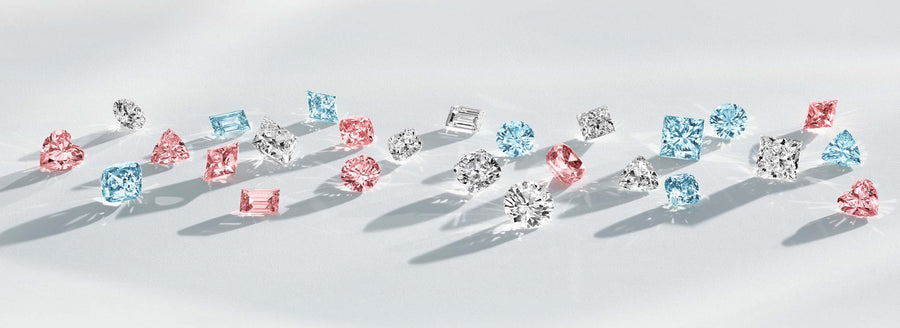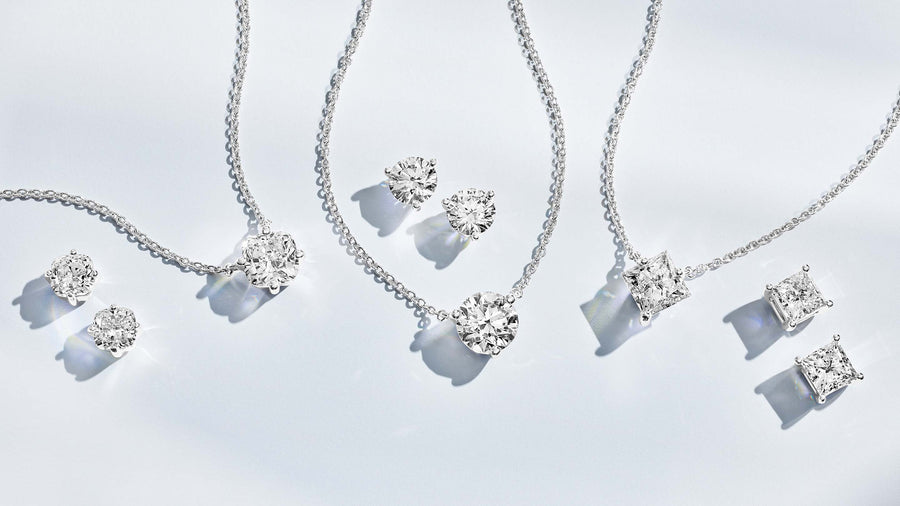The best part of scoring glittering new lab-grown diamond jewelry is when it lands on your doorstep and suddenly every look is elevated. But before that, comes all the fun of fantasizing about the perfect piece that’s just right for you. Luckily, our collection of lab-grown diamonds has something for everyone, including classic studs and eye-catching necklaces—all available in blue and pink, too—along with a trio of metal options and a choice of setting.
One of the most important choices you can make when deciding on a style is picking a diamond shape that suits your personal style. Classic and cool? Round brilliant might be perfect. Modern-yet-trendy? Check out the cushion cut.
Consider this the ultimate diamond shape guide to finding your soon-to-be-treasured, lab-grown diamond for every day. For over 50 years, the team behind Lightbox has used leading technology to create lab-grown diamonds that are all measured as having at least a “very good” cut, to ensure exceptional brilliance, fire, and scintillation.
Here, we’ll cover the history of diamond cutting, types of diamond cuts, different diamond shapes, and how it all impacts light refraction, color intensity, and clarity.

Diamond Cut vs Diamond Shape: What's the Difference?
Okay, admittedly this can get a little confusing—especially since the cut and shape are often used interchangeably—but let’s try and clear this up. A diamond must be cut to create its shape. While it’s common to think of a diamond cut as the stone’s shape (like pear, round, emerald) a diamond cut is a singular term. In other words, the diamond’s shape is the first thing you notice while the diamond’s cut is what gives the stone its sparkle.
A diamond’s cut is one of the 4C’s (many would argue the most important of the 4C’s) and a contributing factor to the diamond’s overall grade. The cut looks at the quality of each tiny surface called a facet. If a diamond has a high-quality cut, then the facets will have been polished with mathematical precision to ensure the facets are in the optimal position to reflect the most amount of light.
Every Lightbox lab-grown diamond has been measured as at least VS. This means the stone has only minor inclusions that cannot be seen by the naked eye, and are difficult to see at 10x magnification.
How does Diamond Shape Affect Sparkle?
The diamond cut directly correlates to diamond sparkle because the cut determines the number of facets, which impacts how light travels through the stone. Facets are like tiny, polished mirrors that help the light reflect and bounce through the stone. While the cut is often considered the most important of the 4C’s, color and clarity—two of the 4C’s—play a significant role, too.
How are Diamond Shapes Created?
Diamond cutting is an art and it takes skilled diamond cutters years to master the precise and exact science needed to turn diamond rough into perfect, sparkly stones. It’s a highly technical process but here is a brief overview to give you a newfound appreciation for the beauty behind the cut and shape of your diamond—be it lab-grown or natural.
First, a piece of diamond rough is carefully studied and notes are made on inclusion locations and the yield of the rough is estimated. The quality and size of the rough determine if you get several stones, a bunch of small diamonds, one large stone, or two stones. Once a plan is made, the stone is marked and ready for cutting.
Next, the diamond is lasered into the previously marked shape and coned off. At Lightbox we only use lasering but if a laser is not used, a special cutting wheel cuts the diamond. The cutting wheel will have diamond powder on it. Since a diamond is the hardest mineral on earth, only another diamond can cut it. Fascinating, huh?
Finally, the diamond is polished until it reaches the desired shape and the facets are polished until they refract the optional amount of white light. Et Voilà.

Popular Diamond Shapes
At InaribyAnkita, we cut our lab-grown diamonds into four of the industry’s most popular shapes: round brilliant, cushion, heart, and princess cut. We know choosing a cut can be a big decision, which is why we have dedicated guides to each of our stone types, which you’ll find throughout this diamond shape guide.
Though there are many shapes on the market, we’re focusing on four specific shapes below. Other popular options include pear, emerald, marquis, Asscher, and emerald.
Round brilliant shaped diamonds
The round brilliant cut diamond is a widely popular diamond shape in both natural and lab-grown diamonds. It features an unmistakable circular silhouette and a cone-like shape—with 58 perfectly placed facets (including the culet). It’s these carefully constructed facets that allow light to perform in a way that’s unparalleled by any other cut. Although other types of round cuts exist—like the vintage old European and rose cuts—the majority of round diamonds seen today are round brilliants.
Princess shaped diamonds
In geometric terms, a princess cut diamond is considered a square diamond and that’s because the stone’s clean edges and crisp straight lines form a stunning square shape that is both modern and edgy. The princess cut is famous for having more than 50 chevron-shaped facets which give the stone an incredible scintillation and sparkle. These iconic chevron patterns create the stone’s well-known ‘X’ pattern that is visible when gazing at a princess cut from above.
Heart shaped diamonds
Modified from a classic round brilliant cut, the heart cut diamond is characterized not only by its classic shape but also by its symmetry. Clarity flaws are more obvious in heart cut diamonds. This is because the diamond’s table, which refers to the upper flat part of the stone, is larger in size allowing for a larger field of vision where flaws can be spotted.
The ideal heart cut diamond should be cut at a length-to-width ratio of 1:1 or 1:1.2. However, this ideal is not necessarily a reality for most excellent cuts. What is necessary is to achieve a cut with 59 facets, which allows the stone to showcase maximum fire and brilliance.
Read our full guide to the heart cut stone and shop our collection of heart shaped
Cushion shaped diamonds
Highly sought after because the stone’s shape offers an antique yet modern feel, the cushion cut is often considered one of the more contemporary cuts. Some cushion cuts can run the gamut from nearly square to nearly round. For most, a classic cushion cut diamond is the perfect marriage between a square diamond and a round brilliant diamond, resulting in a beautiful square cut with rounded corners and edges. When it comes to cushion cuts, there are a few common faceting patterns to choose from: cushion brilliance (known also as a standard cut), old mine cut, and crushed ice. Think of these cuts as cousins, not twins; they’re related by not identical and will impact the sparkle of the stone. For a full understanding of the cut types, check out our cushion shape stone guide and shop our collection of cushion diamonds.
Congratulations! Now that you’ve read this guide you’re a certified armchair expert in diamond shapes and stones. This ceremonial certification—and our lab-grown diamond prices—now allows you to shop with confidence and drop not-so-subtle hints for your next birthday (we’re firm believers that birthdays don’t have to end with a zero to deserve jewelry)!

